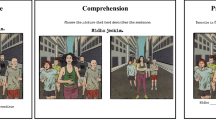Abstract
Oppositeness refers to the paradigmatic relationship of two words holding the contrast meanings. The fact that linguistic opposite differs from logical contrast has been discussed in theories, but has not been tested in practice. In this paper, we investigate three main subtypes of Chinese oppositeness, via using logical tests of negation and double-negation. Result shows that purely logical test does not always work on oppositeness, and indicates that contrast relations within different pairs also vary.
Access this chapter
Tax calculation will be finalised at checkout
Purchases are for personal use only
Preview
Unable to display preview. Download preview PDF.
Similar content being viewed by others
References
Cann, R.: Sense Relations. In: Maienborn, et al. (eds.) Semantics, pp. 456–479. de Gruyter (2011)
Cruse, D.A.: Lexical semantics. Cambridge University Press, Cambridge (1986)
Cruse, D.A.: Meaning in language: an introduction to semantics and pragmatics, 2nd edn. Oxford University Press, Oxford (2004)
Cruse, D.A., Togia, P.: Towards a cognitive model of antonymy. Lexicology 1, 113–141 (1995)
Lehrer, A., Lehrer, K.: Antonymy. Linguistics and Philosophy 5, 483–501 (1982)
Lyons, J.: Introduction to theoretical linguistics. Cambridge U.P., Cambridge (1986)
Lyons, J.: Semantics. Cambridge University Press, Cambridge (1977)
Mettinger, A.: Aspects of Semantic Opposition in English. Clarendon Press, Oxford (1994)
Murphy, M.L.: Semantic Relations and the Lexicon: Antonyms, Synonyms and other Semantic Paradigms. Cambridge University Press, Cambridge (2011)
Liu, S.X.: Chinese Lexical Semantics. Commercial Publication, Beijing (1990) (in Chinese)
Liu, S.X., Zhou, J.: Synonyms and Antonyms. Commercial Publication, Beijing (1992) (in Chinese)
Author information
Authors and Affiliations
Editor information
Editors and Affiliations
Rights and permissions
Copyright information
© 2013 Springer-Verlag Berlin Heidelberg
About this paper
Cite this paper
Ding, J., Huang, CR. (2013). Negation and Double-Negation of Chinese Oppositeness. In: Ji, D., Xiao, G. (eds) Chinese Lexical Semantics. CLSW 2012. Lecture Notes in Computer Science(), vol 7717. Springer, Berlin, Heidelberg. https://doi.org/10.1007/978-3-642-36337-5_74
Download citation
DOI: https://doi.org/10.1007/978-3-642-36337-5_74
Publisher Name: Springer, Berlin, Heidelberg
Print ISBN: 978-3-642-36336-8
Online ISBN: 978-3-642-36337-5
eBook Packages: Computer ScienceComputer Science (R0)




